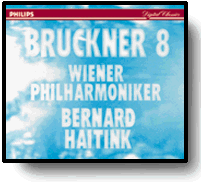


— Sergiu Celibidache
After the remarkable success of the Seventh, Bruckner began sketching the Eighth Symphony in 1884, at the age of 60, completing it three years later, in September 1887 at Steyr in Upper Austria. In October he sent the score to the Munich conductor, Hermann Levi, for his opinion. The great conductor, who had achieved a triumph for the Seventh in Munich, simply could not understand the very different tragic world of this enormous new work. Levi’s rejection of it drove the insecure master almost to suicide. Over the next three years, Bruckner revised the symphony, the most radical alterations being made in 1889 and 1890. Thus he substituted for the original coda of the first movement, which ended with the present quiet ending. For the Scherzo he wrote a completely new Trio, and he moved the climax of the Adagio from C major up a minor third to E flat major. Bruckner dedicated the symphony to the Emperor Franz Joseph I, at whose expanse the full score was printed. The first performance was given on December 18, 1892, in Vienna, under Hans Richter. It was received tremendous acclaim. Hugo Wolf called it "the creation of a giant, surpassing in spiritual dimension and magnitude of conception all the other symphonies of the master". Even Eduard Hanslick, Vienna’s musical pope and one of Bruckner’s fiercest critics, had to acknowledge the work’s greatness. In the Eighth Symphony, Bruckner found the best possible method for ridding himself of his obsessions and of his fanatical search for formal balance. Toils and doubts seem to have been placated by a demonstration of enormous internal security. Here too, however, even within the stupendous harmonic progressions underpinning the musical voyage, everything depends on the details, on those tiny changes of register that lead to intense and unmistakable changes in atmosphere.

 Herbert Von Karajan
Herbert Von Karajan


Among many fine versions of Bruckner’s monumental Eighth Symphony, Karajan’s 1989 recording stands on the top of the catalogue. It is undoubtedly a great performance, tingling with electricity from the opening to the spaciously conceived finale. It conveys an illusion that Karajan and the VPO players are spontaneously composing or improvising this music, and their endeavors have never been surpassed. Every detail of Bruckner’s orchestration is revealed within a highly convincing perspective, and there is a natural spontaneity here. This is a performance in which beauty and truth go hand in hand. The digital recording matches its predecessors in terms of naturalness of detail and depth of perspective.

 Carlo Maria Giulini
Carlo Maria Giulini


Giulini’s account with the VPO is beautifully shaped, both in its overall structure and in incidental detail. The work gains enormously from strong control and deliberate understatement, as well as from the refinement of tone and phrasing which marks this reading, for there is no lack of excitement. The electrically intense playing both holds the structure together and brings out the element of fantasy which literal performances underplay. There is tremendous grandeur as well as a feeling for the natural symphonic current that flows in this great reading. It certainly ranks along with Karajan’s noble version as among the most insightful.

 Bernard Haitink
Bernard Haitink


Haitink’s performance of the Eighth generates great power and depth of feeling, with the most eloquent response from the VPO players. There are plenty of panache and an acute feeling for atmospheric color. With speeds never exaggerated, he avoids vulgarity. The spontaneity Haitink regularly conveys in his recordings is here combined with sharpness of focus. the whole performance has dignity and nobility, and the Philips recorded sound is sumptuous.

 Daniel Barenboim
Daniel Barenboim 


Barenboim’s performance is immediate and direct, with bold primary colors heightening the drama throughout. He brings a fresh mind to this symphony, with his approach very well controlled, giving a strong sense of onward current and producing none of the emotion that can often afflict the slow movement. Barenboim and the Berlin Philharmonic have the advantage of an excellent digital recording. This performance is stunning, full of lyrical ardor and moving forward in a single sweep of great intensity.

 Sergiu Celibidache
Sergiu Celibidache 


The first notable thing about this recording is its length. Celibidache conducts perhaps the longest version of the Eighth along the recording history (around 107 minutes), and he uses the Nowak edition, which is supposed to be the shortest version. However, it is not a loose reading. The effect is breathtaking in its vividness and impact, and there is plenty of excitement and much subtlety of details. This live performance has the advantage of exceptionally rich and present recording with great range and body. Overall, this is a successful reading of Bruckner’s titanic symphony with Celibidache’s unique style.

Other Recommendations:
Günter Wand (1993)

